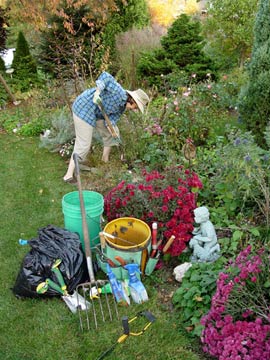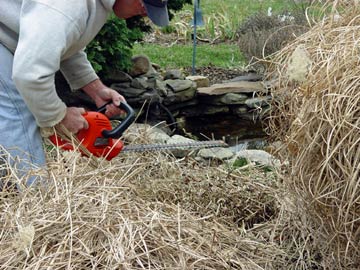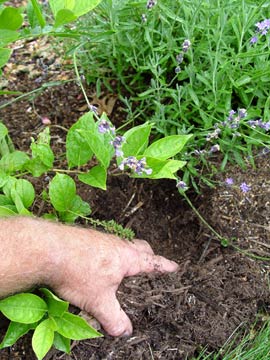 "Triage" your to-do list to get your spring off to a manageable start in the landscape.
"Triage" your to-do list to get your spring off to a manageable start in the landscape.
© George Weigel
The winter siesta is over, and the return of warm weather means it’s time again for gardeners to whip the yard back into shape for another season. Much is on the to-do list this time of year. How to get it all done?
A good starting point is to copy what medics do when wounded demands outpace healing hands – turn to "triage." Triage is a way of prioritizing care. In the landscape, that means separating the "must-do’s" from the "can-waits."
First, ratchet down the pressure. If you don’t get to everything, tell yourself that’s OK. Whether your mums get cut back or not isn’t a life-or-death matter. Also don’t work so hard that you overlook the fresh air, the free exercise, the beauty you’re creating and the health you have to be out there in the first place. You can always play catch-up later. In the meantime, tell people you’re experimenting with a new prairie-style informal design.
Next, triage your to-do list into three parts:
1. Things you really should do right now.
2. Things you can put off until a little later.
3. Things you can do a lot later or maybe not at all.
Prioritizing will help you figure out which is which.
 Trimming back the ornamental grasses is a job best given spring priority.
Trimming back the ornamental grasses is a job best given spring priority.
© George Weigel
Examples:
- You might have a couple of big butterfly bushes that you know will get ridiculously huge by fall if you don’t whack them back now.
- Leaves and assorted debris might be all over the lawn, threatening to smother the grass blades if you don’t rake ASAP.
- Your lousy soil needs a shot of long-acting, granular fertilizer to get your plants off to a good start.
- You have browned-out ornamental grasses that need to be decapitated before new growth starts to intermingle, making the job much tougher later.
- You know you have crabgrass problems in the lawn every year and know that now’s the prime window to put down a crabgrass preventer, such as Greenview with GreenSmart Crabgrass Control plus Lawn Food.
On the other hand, it won’t hurt to put off hedge-trimming a few weeks. It won’t hurt to worry about mulching until May, which is still early enough to insulate the soil from midsummer heat. Neither is it critical to cut sharp new bed edges now. And don’t even think about cutting off any green bulb foliage after the blooms are done. At least wait until the leaves yellow to remove them or you’ll risk weakening future flowering.
As for Priority 3 jobs, early fall is a great time to plant or transplant most trees, shrubs and evergreens if you don’t get to it now. Most shrubs can be thinned out or selectively cut back throughout summer. Mulch can be added in fall if you don’t get to it in spring or summer And jobs such as cleaning the tools, sharpening blades, restocking garden supplies and building plant cages or other gizmos are ones to move to your off-season list.
The location of the would-be job also can be decider. If you've got shrubs that need to be pruned in both the front and back yards, deal with the front ones for now and get to the back ones when time permits.
 Mulching is a job you might be able to skip altogether if you’ve already got 2 or 3 inches over the beds.
Mulching is a job you might be able to skip altogether if you’ve already got 2 or 3 inches over the beds.
© George Weigel
Best of all are jobs you can skip altogether—ere are a few:
- Raking leaves out of garden beds. Don’t think you have to get every last leaf out of the beds at winter’s end. You can mulch right over top of a thin layer of leaves to add organic matter to the soil as the leaves break down. The only leaves that should be removed are those in danger of matting down evergreen groundcovers or ones so plentiful that they threaten to rot woody-plant bark.
- Liming lawns. Too much can be counter-productive. Don’t add lime without knowing that the soil really needs it to correct too-acidy soil.
- Overmulching. If you've already got a 2–3 inch layer, let it ride. Cultivate it if you want, but don’t keep piling up mulch faster than it’s decaying.
Finally, don’t make jobs harder than necessary. Most perennials that have browned out over winter (coralbells, hardy geraniums, leadwort, etc.) can be weed-whacked and raked. Short grasses and grass-like perennials such as liriope can be run over with a lawn mower. That’s easier and quicker than getting down to cut each plant with hand-pruners. Your back will thank you.
A Lawn & Garden Triage List
1. Things you really ought to do now in the yard:
- Rake the lawn, cut it regularly and put down your crabgrass preventer or new seed.
- Cut back late-blooming shrubs such as butterfly bush, rose-of-sharon, caryopteris, beautyberry and summersweet.
- Cut back browned-out ornamental grasses and perennials before new growth begins.
- Prune off cracked and broken branches from winter storms.
- Fertilize the garden beds with a long-lasting, granular fertilizer, such as Greenview with GardenSmart All Purpose Plant Food.
- Prune roses and fertilize them with Greenview with GardenSmart Rose Food.
- Get cool-season vegetables planted, such as broccoli, cabbage, cauliflower, lettuce, spinach, carrots and radishes.
- Get rid of weeds before they spread or go to seed.
- Apply pre-emergent weed control, such as Preen.
- Determine if you’re going to apply any systemic pesticides, such as controls for woolly adelgids on hemlocks or disease controls to head off recurrent problems such as black spot on roses or anthracnose on dogwood.
 Shearing the hedges is a job that can be put off until late spring or summer.
Shearing the hedges is a job that can be put off until late spring or summer.
© George Weigel
2. Things you can put off until a little later:
- Edge the beds.
- Mulch the beds.
- Cut back bulb foliage (wait at least until it yellows).
- Trim the hedges.
- Prune the spring-blooming shrubs, such as lilacs, azaleas, rhododendrons, weigelas, forsythia (wait until right after they’re done blooming).
- Plant containerized annuals, perennials, trees and shrubs… just keep them consistently damp as the temperatures rise after planting.
- Fertilize the garden beds if you didn’t get to it earlier.
3. Things you can put off until much later or the off-season:
- Improve soil in existing beds.
- Dig new beds.
- Plant or transplant new trees, shrubs, evergreens and perennials (fall is excellent).
- Divide perennial flowers.
- Chip prunings.
- Start compost pile or empty existing ones.
- Revamp the garden you really don’t like.
- Build new walls, paths and garden structures.
- Clean garden tools.
- Sharpen dull mower and tool blades now, but put this on the future off-season list.
- Ditto for garden supplies… catch up now, but in the future, inventory and restock in the off-season.